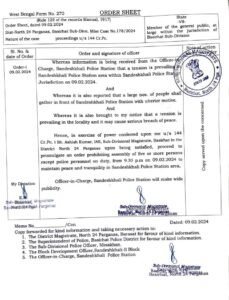Regional shutdown
Sandeshkhali and Hingalganj
On Saturday, 10 February 2024, local authorities in Sandeshkhali, West Bengal, ordered for local Internet services to be suspended as part of Section 144 orders that were imposed to quell violence following two days of protests revolting against local leaders. These orders were extended to the adjacent Hingalganj area on 13 February 'so that tension does not spread to other areas,' according to local reports. The same day (13 February), a single-judge bench of the Calcutta High Court reportedly quashed the orders imposing restrictions under Section 144, saying such prohibitory orders should only be put in place in areas identified as “troubled zone”. Internet shutdowns during protests or civil unrest impact the citizens' ability to get accurate information from government sources when they need it most. It also becomes harder for citizens to contact family members and friends in other parts of the country or other countries.
Local impact
On Saturday, 10 February 2024, local authorities in Sandeshkhali, West Bengal, ordered for local Internet services to be suspended as part of Section 144 orders that were imposed to quell violence following two days of protests revolting against local leaders. These orders were extended to the adjacent Hingalganj area on 13 February 'so that tension does not spread to other areas,' according to local reports. The same day (13 February), a single-judge bench of the Calcutta High Court reportedly quashed the orders imposing restrictions under Section 144, saying such prohibitory orders should only be put in place in areas identified as “troubled zone”. Internet shutdowns during protests or civil unrest impact the citizens' ability to get accurate information from government sources when they need it most. It also becomes harder for citizens to contact family members and friends in other parts of the country or other countries.
Related documentation

Other supporting information
It’s difficult to measure the effect of local/regional Internet shutdowns as most measurements are done at a country level.
Social media
Amid continuing and aggravated protests by the local women at #Sandeshkhali in North 24 Parganas district in West Bengal demanding the arrest of absconding #TrinamoolCongress leader #SheikhShahjahan and his associates, the state administration has extended the internet ban to… pic.twitter.com/rjCWZzDCFE — The Statesman (@TheStatesmanLtd) February 12, 2024
Why is there a need for section 144? Why is the internet cut off? What is 'there' that the administration is trying to hide? Who needs to be threatened and subpressed? Why is the Supreme Court not bothered about #Sandeshkhali women? Not a single candle march! https://t.co/x5V4uMJ9yf — Jaidipta Biswas 🇮🇳 (@Jaidipta) February 13, 2024

